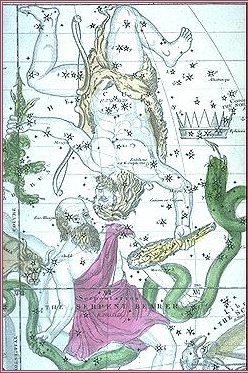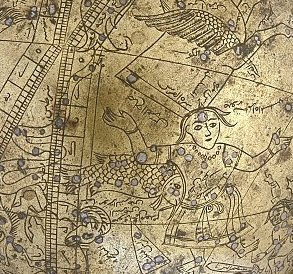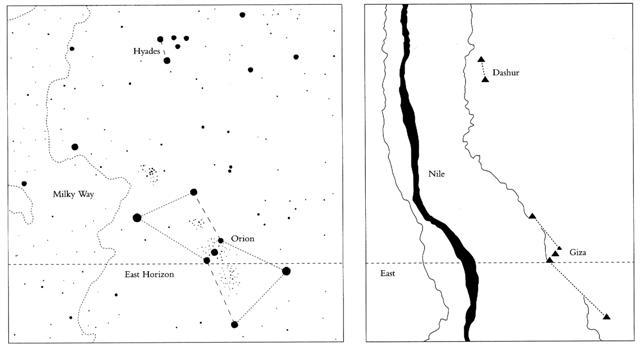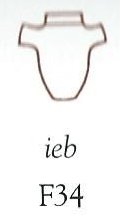There is only one haka-ariki glyph in the G text, but in the C text we can find 3 - all of them on side a of the tablet:
If the first hakaariki was announcing the beginning of a new Rigel (*78) year, then the 2nd could have been connected with Antares and with the 5th Chinese Heart station (σ Scorpii):
From σ Scorpii and right ascension day 224 (= 32 weeks) - at the time of Achernar - up to and including right ascension day 236 (= 8 * 29½) there were 13 days:
... A very detailed myth comes from the island of Nauru. In the beginning there was nothing but the sea, and above soared the Old-Spider. One day the Old-Spider found a giant clam, took it up, and tried to find if this object had any opening, but could find none. She tapped on it, and as it sounded hollow, she decided it was empty. By repeating a charm, she opened the two shells and slipped inside. She could see nothing, because the sun and the moon did not then exist; and then, she could not stand up because there was not enough room in the shellfish. Constantly hunting about she at last found a snail. To endow it with power she placed it under her arm, lay down and slept for three days ... On the other hand was Cursa at the Full Moon in day *236 (= 8 * 29½) = *76 + 160:
A pair of heads - Ras Algethi (α Herculis) and Ras Alhague (α Ophiuchi) may have defined a heliacal season - as if there was a change from one king to another:
The third and last hakaariki is 12 * 29½ = 354 days counted from the beginning of the text. From Ca13-11 (354) to tagata puoko erua (a person with a pair of heads) in glyph 360 there were 6 days and then came the new year:
Manus Catenata close to the Full Moon seems to have been referred to in Ga5-1, with the immobilized arm hanging down at the back side, demonstrating the position of the night side:
In summary - given an adjustment with 1 day: For instance June 13 instead of June 12 at Ca4-7 (i.e. accompanied by heliacal Wezn):
When counting glyphs on the C tablet we will find 392 (side a) + 348 (side b) = 740 = 2 * 408 - 76, and at the time of rongorongo Cursa happened to be with the Sun 76 days after 0h:
Rigel (β) was at the beginning of Orion with Bet-el-Geuze - the House of the Giant, a name derived from Ibt al Jauzah, the Armpit of the Central One - at the other side, on the brink of the River. Centrally located on the Giza plateau were 3 great pyramids, like three gigantic stones for creating a new fire. ... Menkaure was allegedly a much more benevolent Pharaoh than his predecessors. According to legends related by Herodotus, he wrote the following: This Prince (Mycerinus) disapproved of the conduct of his father, reopened the temples and allowed the people, who were ground down to the lowest point of misery, to return to their occupations and to resume the practice of sacrifice. His justice in the decision of causes was beyond that of all the former kings. The Egyptians praise him in this respect more highly than any other monarchs, declaring that he not only gave his judgements with fairness, but also, when anyone was dissatisfied with his sentence, made compensation to him out of his own purse and thus pacified his anger. The Gods however ordained that Egypt should suffer tyrannical rulers for a hundred and fifty years according to this legend. Herodotus goes on: An oracle reached him from the town of Buto, which said 'six years only shalt thou live upon this earth, and in the seventh thou shalt end thy days'. Mycerinus, indignant, sent an angry message to the oracle, reproaching the god with his injustice - 'My father and uncle,' he said 'though they shut up the temples, took no thought of the gods and destroyed multitudes of men, nevertheless enjoyed a long life; I, who am pious, am to die soon!' There came in reply a second message from the oracle - 'for this very reason is thy life brought so quickly to a close - thou hast not done as it behoved thee. Egypt was fated to suffer affliction one hundred and fifty years - the two kings who preceded thee upon the throne understood this - thou hast not understood it'. Mycerinus, when this answer reached him, perceiving that his doom was fixed, had lamps prepared, which he lighted every day at eventime, and feasted and enjoyed himself unceasingly both day and night, moving about in the marsh-country and the woods, and visiting all the places he heard were agreeable sojourns. His wish was to prove the oracle false, by turning night into days and so living twelve years in the space of six ...
Ibt (armpit) ought to be i(e)b (heart) with suffix -t for female. ... In the inscriptions of Dendera, published by Dümichen, the goddess Hathor is called 'lady of every joy'. For once, Dümichen adds: Literally ... 'the lady of every heart circuit'. This is not to say that the Egyptians had discovered the circulation of the blood. But the determinative sign for 'heart' often figures as the plumb bob at the end of a plumb line coming from a well-known astronomical or surveying device, the merkhet. Evidently, 'heart' is something very specific, as it were the 'center of gravity' ... See Aeg.Wb. 2, pp. 55f. for sign of the heart (ib) as expressing generally 'the middle, the center' ...
|
||||||||||||||||||||||||||||||||||||||||||||||||||||||||||||||||||||||||||||||||||||||||||||||||||||||||||||||||||||||||||||||||||||||||||||||||||||||||||||||||||||||||||||||||||||||||||||||||||||||||||||||||||||||||||||||||||||||||||||||||||||||||||||||||||||||||||||||||||||||||||||||||||||||||||||||||||||||||||||||||||||||||||||||||||||||||||||||||||||||||||||||||||||||||||||||||||||||||||||||||||||||||||||||||||||||||||||||||||||||||||||||||||||||||||||||||||||||||||||||||||||||||||||||||||||||||||||||||||||||||||||||||||||||||||||||||||||||||||||||||||||||||||||||||||||||||||||||||








































